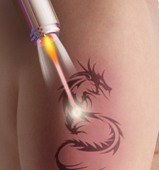Laser Treatment For Tattoos with the PICO Laser

Tattoos are applied with needles using a special ink or other pigments, placed into the dermis of the skin. Applying tattoos to the body is now more popular than ever, especially in our youth! Unfortunately, tattoos are permanent and can pose problems getting jobs because of their negative appeal in the work force. There are many reasons for wanting a tattoo removed. Whatever the reason, the most effective and safest method of removing tattoos is laser treatment. Laser treatment allows for the removal of tattoos of various sizes, colors and shapes. Laser treatment is safer than traditional methods like surgical excision or dermabrasion, because of its unique ability to selectively treat pigment involved in the tattoo, while leaving the overlying skin largely untouched. Blue and black tattoos respond especially well to laser treatment. This very safe treatment currently requires multiple sessions done at minimum monthly intervals, and very often exceeds 15 sessions for the most complete removal.
Procedure
The PICO Laser is the only laser on the market with 3 wavelengths that can effectively treat every color tattoo. Tattoo removal can last from several minutes to an hour depending upon the size and type of tattoo. Anesthesia may be required depending on the location of the tattoo and the pain threshold of the patient. If required, topical anesthesia cream or pain-relieving injections at the treatment site can be used. You will be given protective eye shields to wear during the treatment. The area is cleansed on and around the tattoo to remove oils on the skin. The light from the laser passes harmlessly through the top layer of the skin. When the light hits the brown pigment cells, energy is released. This released energy is then absorbed by certain pigments (colors) within the tattoo. Multiple sessions, usually scheduled at four to six week intervals, are needed to achieve the desired results.
Post operative care
Following the laser treatment, practice the following measures for better results and to avoid any complications.
- Avoid exposure to the sun.
- Use ice packs to soothe and bandages to protect the treated area.
- Use topical cream or ointment as recommended by your dermatologist.
- Avoid scrubbing, picking, or rubbing the treated area.
- Avoid swimming pools during the treatment period.
Side Effects
Laser treatment is associated with certain side effects including infections, hypopigmentation, hyperpigmentation, scarring, blisters, superficial cysts, bleeding, burns, and scab formation.
Contraindications
Patients with a history of skin hypersensitivity, keloids (scarring), skin infections such as impetigo, or are prone to herpes are not advisable for laser treatment.
Schedule your consultation with Dr. Resnik
